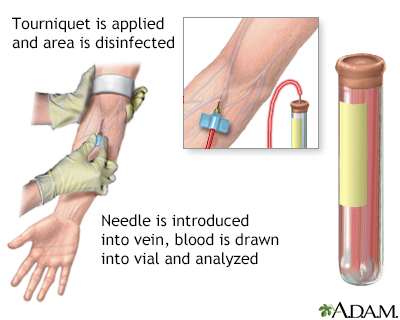Platelet antibodies blood test
This blood test shows if you have antibodies against platelets in your blood. Platelets are particles in the blood that help the blood clot. Sometimes the body may produce antibodies that affect its own platelets.
Antibodies
An antibody is a protein produced by the body's immune system when it detects harmful substances, called antigens. Examples of antigens include micr...

How the Test is Performed
A blood sample is needed.
Blood sample
Venipuncture is the collection of blood from a vein. It is most often done for laboratory testing.

How to Prepare for the Test
No special preparation is needed for this test.
How the Test will Feel
When the needle is inserted to draw blood, some people feel moderate pain. Others feel only a prick or stinging. Afterward, there may be some throbbing or slight bruising. This soon goes away.
Why the Test is Performed
An antibody is a protein produced by your body's immune system to attack harmful substances, called antigens. Examples of antigens include bacteria and viruses. Autoimmune antibodies can be mistakenly directed against one's own cells and produce various diseases.
Antibodies may be produced when your immune system mistakenly considers healthy tissue to be a harmful substance. In the case of anti-platelet antibodies, your body creates antibodies that attack or coat your own platelets. As a result, you will have a lower than normal number of platelets in your body. This condition is called thrombocytopenia, and it can cause bleeding.
Thrombocytopenia
Thrombocytopenia means there is an abnormally low amount of platelets. Platelets are parts of the blood that help blood to clot. This condition is ...
Read Article Now Book Mark ArticleThis test is often ordered because you have a bleeding problem or a low platelet count.
Normal Results
A negative test is normal. This means that you do not have anti-platelet antibodies in your blood.
Normal value ranges may vary slightly among different laboratories. Some labs use different measurements or test different samples. Talk to your health care provider about the meaning of your specific test results.
What Abnormal Results Mean
Abnormal results show that you have anti-platelet antibodies. Anti-platelet antibodies may appear in the blood due to any of the following:
- For unknown reasons (idiopathic thrombocytopenic purpura, or ITP)
ITP
Immune thrombocytopenic purpura (ITP) is a bleeding disorder in which the immune system destroys platelets, which are necessary for normal blood clot...
 ImageRead Article Now Book Mark Article
ImageRead Article Now Book Mark Article - Side effect of certain drugs such as gold, heparin, quinidine, and quinine
Risks
There is little risk involved with having your blood taken. Veins and arteries vary in size from one person to another, and from one side of the body to the other. Obtaining a blood sample from some people may be more difficult than from others. Other risks associated with having blood drawn are slight, but may include:
- Excessive bleeding
- Fainting or feeling lightheaded
- Multiple punctures to locate veins
- Hematoma (blood accumulating under the skin)
- Infection (a slight risk any time the skin is broken)
Reviewed By
Mark Levin, MD, Hematologist and Oncologist, Monsey, NY. Review provided by VeriMed Healthcare Network. Also reviewed by David C. Dugdale, MD, Medical Director, Brenda Conaway, Editorial Director, and the A.D.A.M. Editorial team.
Scott JP, Flood VH. Platelet and blood vessel disorders. In: Kliegman RM, St. Geme JW, Blum NJ, Shah SS, Tasker RC, Wilson KM, eds. Nelson Textbook of Pediatrics. 21st ed. Philadelphia, PA: Elsevier; 2020:chap 511.
Warkentin TE. Thrombocytopenia caused by hypersplenism, platelet destruction, or surgery/hemodilution. In: Hoffman R, Benz EJ, Silberstein LE, et al, eds. Hematology: Basic Principles and Practice. 8th ed. Philadelphia, PA: Elsevier; 2023:chap 130.

 All rights reserved.
All rights reserved.